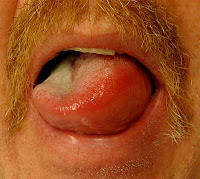Home > Angioedema and hives
Inflammatory mediators such as histamine are produced by basophils and mast cells in the integumentary system and mucosa. Their release is a part of an immune response to pathogens and triggering factors. These inflammatory responses lead to dilation and leakage of blood vessels. The resultant accumulation of body fluids in the intercellular spaces causing the swellings.
Appearance of hives and angioedema
Hives is the result of superficial skin reactions in the upper dermis, leading to pale red, raised bumps. They may cause itchy, stinging or burning sensation. These hives wheals can appear anywhere on the skin surface. The size of the bumps may vary from small spots to large patches of several inches in diameter. Hives may last from a few hours to several weeks.Angioedema is the result of inflammatory responses leading to rapid swelling of the dermis, subcutaneous tissue, mucosa and submucosal tissues. The angioedema often appears around the eyes, lips, cheeks, tongue and throat. It is also observed to develop on the hands, feet, genitals or intestinal tract. Rapidly progressing angioedema in the mouth and the throat must be treated as a medical emergency as the air passage may get blocked suffocating the patient.
Types and causes hives and angioedema
- Hives is considered 'idiopathic' if the cause is not known.
- The skin reaction completely resolving within six weeks is termed 'acute', whereas the condition lasting more than six weeks is known as 'chronic'.
- Various drugs like dextroamphetamine, penicillin, sulfonamides and anticonvulsants have been found to cause allergic reactions.
- Exposure to many physical factors such as stress, scratching, firm stroking (dermatographic), pressure, sweating events, exercise (cholinergic), bathing, sun (solar), heat, cold, water (aquagenic), pressure or some types of food can cause hives.
- Allergens in pollen, animal dander, chemicals, latex, insect venom, cosmetics, detergents etc. can cause skin allergies.
- Angioedema may occur with or without weals. It is classified as either acquired or hereditary.
- The acquired skin reactions may be due to unknown causes (idiopathic).
- The acquired angioedema can be classified as either immunologic or nonimmunologic.
- It can occur as reactions to hypertension medications like ACE inhibitors.
- Hereditary angioedema (HAE) is classified into three forms.
- Hereditary angioedema type I is caused by mutations in the SERPING1 gene, which result in diminished levels of the C1-inhibitor protein.
- HAE type II is caused by mutations in the SERPING1 gene, which result in the dysfunctional forms of the C1-inhibitor protein.
- HAE type III is caused by mutations in the F12 gene.
- All these mutations trigger the complement system causing swellings anywhere in the body.
- In some persons vibration can cause angioedema, especially of hands.
- In some patients, angioedema can progress rapidly into Anaphylaxis or anaphylactic shock causing death.
Signs and symptoms hives and angioedema
Symptoms of hives include superficial raised red, pale red or white wheals which can be of varying sizes with itchy sensation. Sometimes there may be burning or stinging sensations. The swellings may last for a few hours to a few days in the acute form and may last for months and years in chronic form.Angioedema is characterized by large thick swelling. The affected area may be itchy, firm and warm and it may be painful when squeezed or pressed. The swellings may appear on any part of the body. Angioedema may appear as sudden and severe swelling. If it is associated with the gasstrointestinal system, 'abdominal attacks' may occur with symptoms like intense stomach pain and cramps. The swellings in the mouth, tongue, larynx or throat may show symptoms like gasping or wheezy inspiratory breath sounds.
The angioedema may sometime become life-threatening due to blocked airway.
Diagnosis and treatments for hives and angioedema
Mild hives or angioedema does not require treatment. Identifying triggers and avoiding them can help greatly. If the skin reaction is severe, persistent, very itchy or causing severe discomfort, many treatment options are available. Antihistamines are the drugs of choice for treating angioedema and hives.First-generation antihistamines like hydroxyzine, diphenhydramine and chlorpheniramine are helpful when the symptoms of angioedema are severe and involve swelling on the face, tongue or throat. These medications can cause drowsiness, blurred vision, reduced reflex actions and reduced physical coordination.
Second-generation antihistamines include loratadine, desloratadine, fexofenadine, levocetirizine and cetirizine. These antihistamines have lesser side effects. Chronic cases of hives and angioedema may respond well to steroid therapy with prednisone, hydrocortisone, fluocinonide, or desonide. Type H2 antihistamines such as ranitidine, cimetidine and famotidine when given along with type H1 antihistamines treat angioedema and hives.
Epinephrine may be life-saving in severe rapidly progressing allergic angioedema. For treating hereditary angioedema certain androgens, such as dexamethasone, danazol and methyltestosterone have been found to be effective on a long-term basis. In treating hereditary angioedema, Cinryze and Berinert derived from human blood plasma have been found to be effective.
2.Image source: http://en.wikipedia.org/wiki/File:Angioedema2013.JPG
Images author: James Heilman, MD
Images license: Creative Commons Attribution-Share Alike 3.0 Unported license.
Popular topics on skin care:
Natural remedies for acne scars.
Dry skin around the mouth.
Homemade skin treatments.
Types of acne scars.
Keratinocyte cells.
Definition of epidermis.
Five layers of epidermal skin in order.
Skin discoloration pictures.
Stratum granulosum definition.
Stratum lucidum definition.
Natural remedies for acne scars.
Dry skin around the mouth.
Homemade skin treatments.
Types of acne scars.
Keratinocyte cells.
Definition of epidermis.
Five layers of epidermal skin in order.
Skin discoloration pictures.
Stratum granulosum definition.
Stratum lucidum definition.
Hives and angioedema


No comments:
Post a Comment